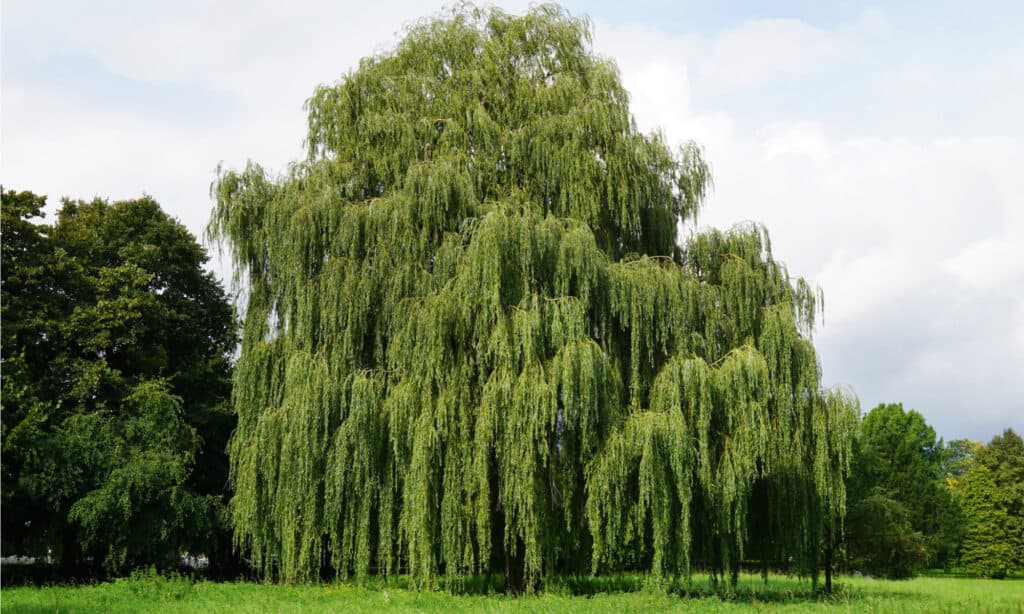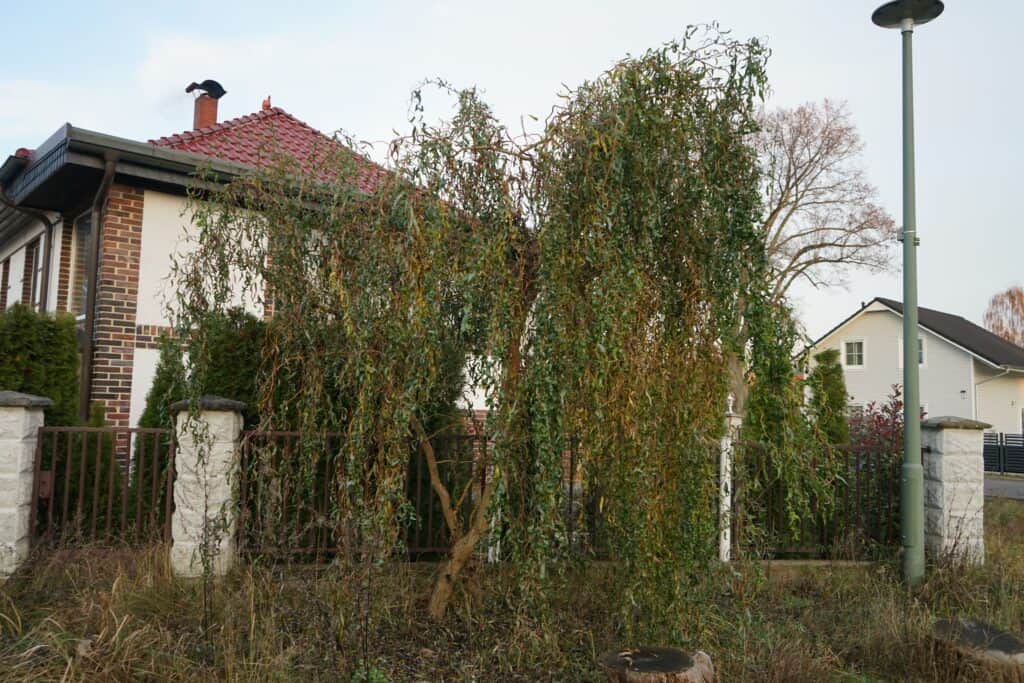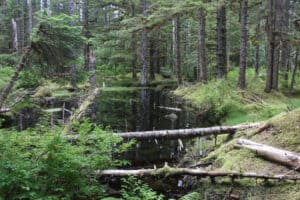As you can tell by their names, Corkscrew and Weeping Willows are both types of willow trees, so they have many traits in common, being so closely related. However, they’re unique trees with unique appearances and growing habits.
If you’re interested in growing either of these trees in your landscaping or want to learn to identify different willow trees, it’s essential to tell them apart and know where and how they grow. So, let’s get into it!
Corkscrew Willow vs. Weeping Willow
| Corkscrew Willow | Weeping Willow | |
|---|---|---|
| Species | Salix matsudana ‘Tortuosa’ | Salix babylonica |
| Looks | Medium-sized, with a full crown of twisted branches and curled leaves | Large tree with a full crown of branches that hang down and cover the tree |
| Size | 20-30 ft tall by 10-15 ft wide | 30-50 ft tall by 30-50 ft wide |
| Soil Type | Moist, well-drained | Moist to wet, poorly-drained |
| Water Needs | Average moisture in the soil without it being soggy | High water intake, always soaking in water |
| Growing Zones | 5-8 | 6-8 |
About Corkscrew Willows
Corkscrew Willows have a super interesting look that is different from any other willow tree, making them increasingly popular for landscaping. Corkscrew Willows are also sometimes called Dragon’s Willow or Curly Willow.
As their name suggests, Corkscrew Willows have curled branches and twigs that twist like a corkscrew, and even their leaves curl! The branches of these trees are often added to floral arrangements because they hold their intriguing curled form even after coming off the tree.
Corkscrew Willows, as with most types of willow trees, repel deer and thus don’t have any issues with deer eating the bark or leaves. All trees in the willow genus are native to central and eastern Asia, and the Corkscrew Willow is specifically native to northern China and Korea.
About Weeping Willows

Weeping Willows are iconic and referenced in many movies and books.
©Axel Bueckert/Shutterstock.com
Weeping Willows are likely the most well-known species of willow, with their iconic look that everyone knows- even from references in movies or literature. The Weeping Willow is beautiful in its own right, but it also has a rich history of symbolic importance in many Asian cultures and has found its place in Western culture.
Its botanical name, Salix babylonica, comes from the botanist that studied this tree and believed it was the tree of Babylon from the Bible. There are still a lot of questions and investigations about this theory, but it shows how long Weeping Willows have been important to humans!
There’s lots of confusion about whether a Weeping Willow is the same as a willow tree and the differences. Simply put: yes, a Weeping Willow is a type of willow tree. It’s one of several species of willow trees. Many other trees will be called a Willow, but that doesn’t mean they’re a Weeping Willow.
Weeping Willows are large, deciduous trees that are also deer resistant.
Appearance
Corkscrew Willow and Weeping Willow each have very distinct looks, so it’s really easy to tell them apart just by looking!
As I explained, Corkscrew Willows have twisted branches and leaves that you’ll notice year-round. In the spring and summer, you can see the curled twigs behind the green leaves; then, the leaves drop in fall, and the tree’s twisty silhouette is visible all through winter.
The branches grow upwards to form a rounded, open crown. The tips of the branches droop down a bit, but nowhere near as much as Weeping Willows.
As for Weeping Willows, I’m sure you know that long branches hang down and create a curtain covering the tree all around. Weeping Willow leaves are light green, slender, and about 4 inches long, which adds to the hanging effect of the branches.
In spring, Weeping Willows bloom with fluffy green catkin flowers several inches long, with male and female flowers on separate trees. In late summer and fall, the leaves turn slightly yellow, then drop in mid-fall, revealing a skeleton of drooping branches.
Size
Corkscrew Willows are medium-sized trees and are quite smaller than Weeping Willows. They often only grow to about 30 feet tall, making them more practical for landscaping. Weeping Willows are much larger trees that can grow to 50 feet tall, sometimes with a 50-foot spread!
Growing Zones
Corkscrew Willows can grow in USDA hardiness zones 5 through 8, which cover most of the U.S. These trees are more cold-hardy than many willow trees and can handle cold temperatures better than Weeping Willows can.
However, the branches on Corkscrew Willows are fragile, so they can get damaged easily by ice storms or heavy winds. So, for those living in regions with intense winter storms, you may be better off not growing a Corkscrew Willow.
Weeping Willows can only grow in zones 6 to 8 since they have a lower tolerance for cold temperatures. However, zones 6 to 8 include most states in the southern U.S., so there are still many regions that can grow Weeping Willows.
Weeping Willows are an excellent choice for growers in these regions since these trees are very easy to grow and require little maintenance.
Growing Habits: Corkscrew Willow Vs Weeping Willow

Corkscrew Willows have twisted branches and leaves that you’ll notice year-round.
©crystaldream/Shutterstock.com
Corkscrew and Weeping Willows are straightforward trees to grow and are great picks for any landscape in their growing regions. However, considering that Corkscrew Willows have a very different shape than Weeping Willows, you can understand that they have very different growth patterns and traits.
Corkscrew Willows grow much faster than Weeping Willows, generally at 2 feet per year. Since they’re not giant trees, they can reach their mature height in just a few years.
This fast growth rate also means that these trees aren’t very robust and often grow too quickly to develop strong wood. This makes them vulnerable to intense storms with high winds or ice, which often cause damage to the bark and expose the tree’s interior to pests or diseases.
Corkscrew Willows are often short-lived trees that last for about 15 years, but around this time, their branches become very weak and start to drop. Either the branches fall on their own, or the tree becomes infected and begins to rot.
A Word Of Caution
In either case, it’s best to plant this tree safely away from any structures that falling branches could damage. These trees have shallow but strong roots that can easily crack concrete, damaging driveways or patios.
A positive about growing these trees is that they don’t take up much space, so you just need a little area where they can grow- and their crown is upright, high above the ground, and provides lots of shade.
Weeping Willows present a similar concern with their shallow root system, quickly breaking up above-ground structures obstructing the roots.
However, Weeping Willow trees are much bigger than Corkscrew Willows and will need space for both their branches and roots.
Weeping Willows don’t grow as quickly, but they live much longer. Weeping Willows are the kinds of trees that can be enjoyed for generations and become family heirlooms.
If you’re planting a Weeping Willow, it’s a great idea to plant this tree near a source of water where it can soak up moisture as it needs because these trees are heavy drinkers! This is why we often see Weeping Willows growing along streams or riverbeds.
Corkscrew Willow Vs Weeping Willow: Soil Type
Corkscrew and Weeping Willows can handle a range of soil types and generally can grow in soil with a neutral or acidic pH. They’re both able to grow in moist, clay, sandy, or loamy soil, but they have their preferences.
Corkscrew Willows are adaptable to different soil types but do best with well-draining and moist soil. This kind of soil is common in most areas in its growing zones with fertile soil, so it’s quite easy to plant this tree with good soil.
Weeping Willows are a bit more forgiving with soil types and can handle a broader range of conditions- as long as they receive enough water! Weeping Willows will also grow in moist and fertile soil, but they can grow even better in wet, poor-draining soil.
Water Needs
Corkscrew Willows have moderate water needs and can often grow fine with frequent rains. They only need to be watered if you’re experiencing a dry spell and the soil is becoming dehydrated.
Corkscrew Willows will be fine as long as there’s moisture in the ground. However, if the soil is too dry, the roots will spread out and search for water, which could lead to roots disrupting nearby structures.
Weeping Willows, on the other hand, are hefty drinkers and will need a constant source of water. If you’re not growing one in a place where it can soak up water on its own, you’ll need to water it very frequently and use lots of water.
Sunlight Needs
Corkscrew Willow and Weeping Willows both thrive in full sun and will grow upwards towards the sun if they’re covered in too much shade. However, these trees handle partial shade and will still be healthy if they grow in speckled light.
Corkscrew Willow Vs Weeping Willow: Pruning
Corkscrew and Weeping Willow don’t need regular pruning and will be completely healthy if left to grow on their own. Although, it’s helpful to prune these trees yearly to manage their size if you’re growing one in your yard.
Also, stay mindful of the Corkscrew Willow’s vulnerability to disease and dead branches that result from this. Do a yearly check on your tree to ensure the branches are intact and proactively remove any diseased ones.
Because these trees have shallow roots, they’re easily damaged by lawnmowers. Be careful not to hit their roots since this will seriously shock the entire tree.
Pests and Diseases
Corkscrews and Weeping Willows are home to many insects that live in and feed off the tree, but most of these are entirely harmless- if not beneficial! However, sometimes this gets out of hand, and the tree is overwhelmed, causing its growth to slow.
The most common problem is with aphids, tiny insects that take over the entire tree and eat more than the tree can keep up with. Because these bugs are so small, you likely won’t see them but will notice that the tree has become barren before the leaves have even dropped.
Other common insects with willow trees include sawflies and various beetles or caterpillars. These typically aren’t invasive but can occasionally be.
Willow Siblings
These two willows have many different traits- their looks, size, and growing habits- but they’re still closely related and share many common features. Take either of these two willows compared with a Pine tree, for example, and you’ll find many more differences.
If you’re thinking about planting either of these trees, keep all these differences in mind to see which best suits your situation. I hope this article showed you the distinction between Corkscrews and Weeping Willows!
Up Next
- Black Willow vs Weeping Willow: What’s the Difference?
- Discover 11 Different Types of Willow Trees
- Willow Warbler
The photo featured at the top of this post is © Axel Bueckert/Shutterstock.com
Sources
- Gardenia , Available here: https://www.gardenia.net/plant/salix-babylonica
- Zack DeAngelis, Available here: https://treejourney.com/differences-similarities-between-willows/
- Julie Christensen, Available here: https://www.gardeningchannel.com/how-to-grow-corkscrew-willow/
Thank you for reading! Have some feedback for us? Contact the AZ Animals editorial team.






